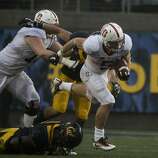While Stanford and Cal were tussling in the rain at Memorial Stadium on Saturday, another battle between the two schools raged down the road in a much more surprising setting.
In front of a crowd of a few thousand people at Oracle Arena and nearly 40,000 more watching online, Stanford defeated Cal 27-26 in a League of Legends “Big Game show match” during the Intel Extreme Masters, one of the top competitive gaming events in the nation.
“It’s a big rivalry, and the fact it was on a big stage and streamed online – it felt like the Big Game of video games,” said Cal’s Alex Pao, 19, who admitted that his heart rate went up a little bit when he saw the size of the crowd and heard fans cheering.
E-sports do big business – the same IEM event drew 10,000 fans at SAP Center in San Jose last year, and some tournaments have drawn more than 100,000 people, with another 20-35 million watching online. Investors, including some traditional pro sports teams, are flocking to get a piece of the action; Warriors co-owner Peter Guber co-owns Team Liquid, a multi-e-sport outfit with teams competing in many of the most popular games, including League of Legends and Dota 2.
Collegiate e-sports is viewed as the next big thing now that several pro leagues are seeing such massive success, and there is a very good chance that within the next year, there will be an organized collegiate e-sports league that includes traditional conferences, including the Pac-12, and, eventually, scholarship players.
“College sports is a very important place,” said Steven Roberts, the executive chairman of ESL, which organizes e-sports events, including this weekend’s event at Oracle. “Having this during Big Game weekend – that was a natural extension for us. It was a great weekend to give these college e-sports players their moment in the sun.
“E-sports is still in its growth state, but you’re going to see more and more of it at the collegiate level and we want to formalize it like any other sport. College sports is something special and these students spend just as much time practicing, much as time training. This will give them a chance to get involved with playing for their school, allow them to be part of the pageantry of collegiate sports.”
The Stanford-Cal League of Legends game Saturday was one that will sound familiar to those who follow the traditional football rivalry – Stanford started off strong then faded, and Cal dominated the latter portion of the proceedings…..until the five-man Bears team made far too aggressive a move right near the end, trying to go for the win. The move backfired.
“We felt like we were going to win the whole time, but at the end we did make some mistakes,” Pao said. “We were definitely too ambitious.”
Stanford’s five players – who had regrouped and shifted strategies after falling behind – went on a counter-attack and won by a point with a big triple-kill just before time expired.
“We use the term ‘tilt’ once the momentum gets you, but we kept a positive attitude and at the end, that helped us,” said Gabriel Saldivar, an 18-year-old Stanford student from Menlo Park.
None of the gamers planned to head over to the gridiron-style Big Game afterward, although they might have been able to catch the second half. Nor did they plan to watch the football game on TV.
“Cal’s team is so bad, and Stanford’s not much better,” Pao said, as all the players from both teams nodded in agreement. “For me, this is the Big Game.”
Susan Slusser is a San Francisco Chronicle staff writer. Email: sslusser@sfchronicle.com. Twitter: @susanslusser







